
The black kite is a medium-sized bird of prey in the family Accipitridae, which also includes many other diurnal raptors. It is thought to be the world's most abundant species of Accipitridae, although some populations have experienced dramatic declines or fluctuations. Current global population estimates run up to 6 million individuals. Unlike others of the group, black kites are opportunistic hunters and are more likely to scavenge. They spend much time soaring and gliding in thermals in search of food. Their angled wing and distinctive forked tail make them easy to identify. They are also vociferous with a shrill whinnying call. This kite is widely distributed through the temperate and tropical parts of Eurasia and parts of Australasia and Oceania, with the temperate region populations tending to be migratory. Several subspecies are recognized and formerly had their own English names. The European populations are small, but the South Asian population is very large.

The lineated woodpecker is a very large woodpecker which is a resident breeding bird from southern Mexico to northern Argentina and on Trinidad in the Caribbean.

Prochilodus lineatus, the streaked prochilod, is a species of ray-finned fish in the family Prochilodontidae. It is native to the Paraná—Paraguay and Paraíba do Sul river basins in South America. It performs long breeding migrations and supports very important fisheries.
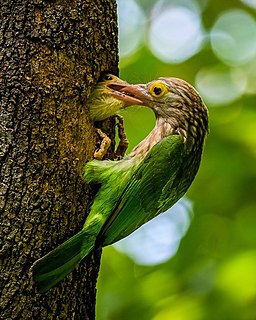
The lineated barbet is an Asian barbet native to the Terai, the Brahmaputra basin to Southeast Asia. It is a frugivore and nests in holes of tree trunks.
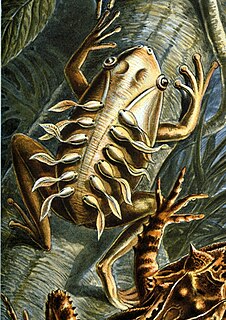
Craugastor lineatus, also known as the Montane robber frog, is a species of frog in the family Craugastoridae. It is native to Guatemala and southern Mexico. It lives in lower montane evergreen forests.
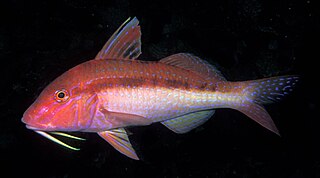
Upeneichthys lineatus, also known as the blue-striped mullet, blue-lined goatfish. blue-striped goatfish, blue-spotted goatfish and blue striped red mullet, is a species of marine ray-finned fish, a goatfish from the family Mullidae. It is native to the Pacific coast of Australia. It occurs in sheltered areas over rocky and sandy substrates and can be found 5 to 100 metres, though rarer below 40 metres (130 ft). This species can reach a length of 40 centimetres (16 in) FL. This species is commercially important.

Halaelurus is a genus of catsharks in the family Scyliorhinidae.

The white-lined broad-nosed bat is a bat species from South America. It is found in southern and eastern Brazil, Paraguay, Uruguay, northern Argentina, Bolivia, Peru, Ecuador, Colombia, French Guiana and Suriname.

The lined catshark or banded catshark is a species of catshark, belonging to the family Scyliorhinidae. It is found in the waters off the coasts of Beira, Mozambique, to East London, and South Africa between latitudes 19°S and 31°S, from the surface to 290 m. It can grow up to 56 cm in length.

Lithodytes is a genus of frogs in the family Leptodactylidae. It is monotypic, being represented by the single species, Lithodytes lineatus, the gold-striped frog or painted antnest frog. It is found in tropical South America where it lives in humid forests among the leaf litter. These frogs build foam nests at the edge of temporary pools, and the tadpoles develop within these. The frogs also associate with certain leafcutter ants and breed inside their nests without being attacked by the ants.
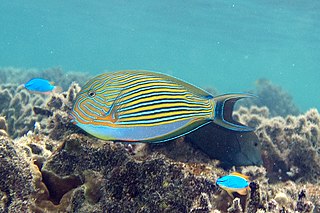
Acanthurus lineatus, the lined surgeonfish, is a member of the family Acanthuridae, the surgeonfishes. Other common names include blue banded surgeonfish, blue-lined surgeonfish, clown surgeonfish, pyjama tang, striped surgeonfish, and zebra surgeonfish.

Euthynnus lineatus, the black skipjack tuna or black skipjack, is a species of ray-finned bony fish in the family Scombridae. It belongs to the tribe Thunnini, better known as the tunas.

Surface wave detection by animals is the process by which animals, such as surface-feeding fish are able to sense and localize prey and other objects on the surface of a body of water by analyzing features of the ripples generated by objects' movement at the surface. Features analyzed include waveform properties such as frequency, change in frequency, and amplitude, and the curvature of the wavefront. A number of different species are proficient in surface wave detection, including some aquatic insects and toads, though most research is done on the topminnow/surface killifish Aplocheilus lineatus. The fish and other animals with this ability spend large amounts of time near the water surface, some just to feed and others their entire lives.
Copelatus lineatus is a species of diving beetle. It is part of the genus Copelatus in the subfamily Copelatinae of the family Dytiscidae. It was described by Félix Édouard Guérin-Méneville in 1838.

Plotosus lineatus, common name striped eel catfish, is a species of eeltail catfishes belonging to the family Plotosidae.

The red-shouldered hawk is a medium-sized hawk. Its breeding range spans eastern North America and along the coast of California and northern to northeastern-central Mexico. It is a permanent resident throughout most of its range, though northern birds do migrate, mostly to central Mexico. The main conservation threat to the widespread species is deforestation.
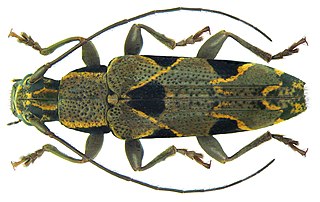
Tmesisternini is a tribe of beetles in the subfamily Lamiinae containing the following genera:
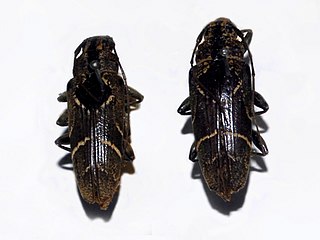
Tmesisternus is a genus of longhorn beetles belonging to the family Cerambycidae, subfamily Lamiinae.
Tmesisternus jaspideus is a species of beetle in the family Cerambycidae. It was described by Jean Baptiste Boisduval in 1835.
Tmesisternus schaumii is a species of beetle in the family Cerambycidae. It was described by Francis Polkinghorne Pascoe in 1867. It is known from Moluccas, Australia, and the Solomon Islands.
















